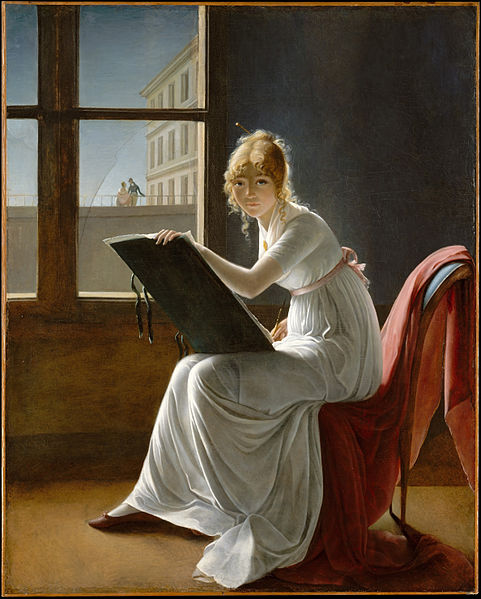
Wiki / KulturellKreative
Inhaltsverzeichnis: (verbergen)
 Junge zeichnende Frau, 1801 |
|
Man muss in die Stille hören, |
|
Kulturell Kreative (KK) sind Menschen, die zeitloses Wissen und die Weisheit jenseits des Schulwissens in ihrer jeweiligen Kultur schöpferisch zum Ausdruck bringen. Sie wissen um die Rhythmen des Lebens, die Größe und Wirkkraft des Seins, das Unaussprechliche des Tao.
Die Fortgeschritteneren unter den transkulturell Schöpferischen übernehmen eine Brückenfunktion zwischen
|
Wer erstmals auf den Begriff "'Kulturell Kreative" stößt, mag glauben, es handle sich dabei um Künstler, die in den traditionellen "Kultur"-Bereichen Theater, Museen, Musik und Malerei tätig sind. Um dies zu vermeiden und deutlich zu machen, dass es sich um eine wertewandelnde Bewegung handelt, die im Begriff ist, insgesamt eine neue Kultur zu schaffen und zu prägen, empfeh-
len einige Redaktionen kulturkreativer Medien sowie des Club of Budapest WorldShift Network, unter dessen Schirmherrschaft weltweit Studien zu dem Thema Kulturkreative durchgeführt werden, künftig im Deutschen den zusammengezogenen Begriff "Kulturkreative" zu verwenden. Hier liegt die Betonung auf "Kultur", und es wird offenkundiger, dass es sich um einen zivil-
gesellschaftlichen Prozess handelt, der kein "kulturtechnisches" Spezialwissen voraussetzt. Diese Begriffsklärung wurde mit Dr. Paul H. Ray, der den Terminus "cultural creatives" geprägt hat, diskutiert und abgestimmt.
»Wir stecken zur Zeit zwischen zwei Geschichten. Die Wahrnehmung der Welt funktioniert nicht mehr, und die neue Geschichte kennen wir noch nicht. Es ist aber eine neue hoffnungsvolle und schöpferische Phase im Lebensbogen unserer Kultur angebrochen, die gewöhnlich auf eine Phase des Niedergangs und der Verzweiflung folgt. Beides ist nicht eine Folge von Unglück, sondern nur das Resultat der alten Geschichten, die nicht mehr funktionieren. Die Kulturell Kreativen werden auf ganz konkrete Weise ihren Beitrag zur Gestaltung der neuen Zukunft leisten.«
Dr. Paul H. Ray, amerikanischer Professor für Anthropologie und Soziologe an der Universität von Michigan und seine Frau, die Psychologin Dr. Sherry Ruth Anderson, haben die weltweit zu beobachtende Bewegung der Kulturell Kreativen nicht gesucht, sondern anhand ihrer 13 Jahre dauernden sorgfältigen Werte-Studie (1986-1999) mit 100.000 Befragten gefunden.
Demzufolge schätzte das Forscherpaar, dass sich 50 Millionen Menschen im Prozess des Erwachens in den Vereinigten Staaten von Amerika und 70-80 Millionen in Europa befinden (Stand 1999).
Hochgerechnet innerhalb einer Dekade dürfte sich die Anzahl der Kulturell Kreativen auf 70 Millionen in den Vereinigten Staaten und auf 100 Millionen in Europa erhöht haben (Stand 2009).
Rays Langzeitstudie über die Transformation der Werte der Bevölkerungsstruktur unter-
suchte drei Hauptgruppierungen näher. Erst im Jahr 2006 wurde er auf eine vierte aufmerk-
sam, die sich deutlich von der dritten abhebt.
|
| Quelle (engl.): ► Audiointerview mit Dr. Paul H. Ray, US-amerikanischer Professor der Anthropologe und Soziologe, Universität von Michigan Autor, Dr. Sherry Ruth Anderson (*1942) US-amerikanische Psychologin, Autorin, Co-Creating a New Wisdom Culture, Episode 37, präsentiert von dem US-amerikanischen Webradiosender Personal Life Media, Programm Living Dialogues, Gastgeber Duncan Campbell (*1952) britischer Produzent von Fernsehsendungen, unabhängiger investigativer Journalist, Autor, 31:07 Minuten Dauer, gesendet Ende 2007 |
| Siehe auch: ► '''Informationszeitalter ⇒ Konzeptuelles Zeitalter (mit menschenzugewandten Dienstleistungen) – Daniel Pink |
| See also: ► Results of long-term value study – Paul Ray |

Großer Raubfisch
Das alte
profitmaximierende
ausschließende
beherrschende
korrupte System
nimmt ab.

Großer sich selbst organisierender Fisch
Das neue
ganzheitliche, sich erneuernde
zugewandte, soziale
ebenbürtige
einschließende System
wächst heran.
↑
|
Klimawandel und Wertewandel bauen sich über einen langen Zeitraum auf. Er leitet einen Paradigmenwechsel ein.  Kontinentaldrift der letzten 150 Millionen Jahre
Seit Anfang der 60er Jahre bildete sich die inzwischen beträchtlich große Gruppe der Kulturell Kreativen heraus, die öffentlich und nach-
In allen durchgeführten Wertestudien auf nationaler Ebene wurde deutlich, dass der Frauenanteil unter den Kulturell Kreativen je-
Die Wertestudien in Europa nach 2000 wiesen einen deutlich hö-
Im Jahr 2006, sieben Jahre nach dem Erscheinen seines Buchs The Cultural Creatives. How 50 Million People Are Changing the World, hat Ray festgestellt, dass in den Vereinigten Staaten von Amerika und Europa insgesamt |
|
| Siehe auch: ► Gemeinschaft: Informationszeitalter ⇒ Konzeptuelles Zeitalter ⇒ Andere Dienstleistungen – Daniel Pink |
Leitfiguren der Bewegung des Neuen Zeitalters und des Integralen Denkens wie
glauben und tun kund, dass ein Prozess der globalen Transformation eingesetzt hat.
Der erwachende Engländer Arjuna Ardagh hat für sein Buch Die lautlose Revolution (September 2006), welches das Phänomen des Erwachens von transluzenten (lichtdurchlässigen) Menschen beschreibt, 170 Experten aus der Szene, unter anderem auch Dr. Paul H. Ray, befragt und kam zu folgendem Ergebnis:
Sie leben auf eine Weise, die bemerkenswert wenig Ego-bezogen ist, sagt Ray. Sie haben teilweise Zugriff auf das Göttliche oder das 'Nicht-Selbst'. Er schätzt diese Gruppe auf ein bis zwei Millionen Menschen in den Vereinigten Staaten, obwohl er gleichzeitig warnt: Groß angelegte Umfragen decken das nicht ab, denn man braucht Interviews, die in die Tiefe gehen.
Duane Elgin, ein anderer Soziologe, ist zu ähnlichen Schlussfolgerungen gekommen und ist sogar noch optimistischer in seiner Einschätzung. Wenn Forscher wie Ray und Elgin Recht haben, dann sind das sehr bemerkenswerte und gute Nach-
richten. Es ist diese Veränderung in dieser großen Anzahl, die jede spirituelle Tradition angestrebt hat.
Arjuna Ardagh (*1957) britisch-US-amerikanischer spiritueller Lehrer, Autor, Die lautlose Revolution. Wie eine im Alltag gelebte Spirituali-
tät uns und die Welt verändert, S. 83-84, J.Kamphausen Verlag, 14. September 2006
Laut Karl Gamper (*1949), dem österreichischen Repräsentant des Club of Budapest, vertritt inzwischen ein Drittel der Bürger der Ersten Welt die Grundhaltung der Kulturell Kreativen. Es handelt sich um Menschen guten Willens, denen nicht der Sinn nach pharisäerhaftem Weltverbesserertum steht.
| Siehe auch: ► Das Göttliche Gesetz |
Nach der ⚡ Skala des Bewusstseins des Wahrheitswissenschaftlers Dr. David R. Hawkins liegt der durchschnittliche Bewusst-
seinsgrad der Kulturell Kreativen bei Bewusstseinswert 3351, während das allgemeine Bewusstseinsniveau weltweit lediglich
bei Bewusstseinswert 206 [Stand: Oktober 2010] liegt.
Die vom Mainstream nur marginal gewürdigte unaufdringliche KK-Bewegung trägt wesentlich zum Ausgleich der bestehenden Verhältnisse bei. Nach Hawkins hält jeder KK-Angehörige im Schnitt die Negativität von mehr als 100.000 nichtlauteren Men-
schen in Schach, während das zur Schau gestellte Pharisäertum von so genannten Gutmenschen es lediglich auf einen Be-
wusstseinsgrad von 190 bringt, der sich letzten Endes als energieraubend erweist.
|
| Literatur von M. Scott Peck (1936-2005) US-amerikanischer Psychiater, Psychotherapeut, Schriftsteller: ► Gemeinschaftsbildung. Der Weg zur authentischer Gemeinschaft, Eurotopia Verlag, 4. Auflage Oktober 2007 ► Der wunderbare Weg. Eine neue spirituelle Psychologie, Erstauflage 1978, Goldmann Verlag, Neuauflage 1. Juni 2004 |
| Siehe auch: ► Stufenmodelle und ► Vier Seinsebenen – Hartmann • Gebser • Heim |
| See also: ► Four stages of spiritual development – M. Scott Peck |
|
[LoC 460-499-500+]
|
| Value Study by sociologist Paul H. Ray (1986-1999) |
| Newly emerging population groups: the Cultural Creatives / the Spiritually Awakening |
| Based on 13 years of survey research with 100,000 proponents among 100 focus groups and dozens of interviews US American sociologists Paul H. Ray, Ph.D., US American sociologist, founding partner of Integral Partnerships, con- sultant of Cultural Creatives, author and his wife psychologist Sherry Ruth Anderson, Ph.D. issued and presented this long-term value study at the break of the millennium. Ray / Anderson posit that hidden within America so called cultural creatives are emerging (50+ million people). Demographics are shifting. Hence the distribution (%) of different value groups within the US population is shifting. |
|
| Source: ► Audio interview with Paul H. Ray, Ph.D., US American sociologist, founding partner of Integral Partnerships, consultant of Cultural Creatives, author, Co-Creating a New Wisdom Culture, episode 37, presented by the US American free web audio channel Personal Life Media, program Living Dialogues, host Duncan Campbell (*1952) British television producer, freelance investigative journalist, author, 31:07 minutes duration, aired end 2007 |
| Reference: en.Wikipedia entry ► Cultural Creatives | |||
| See also: ► Consciousness-Tables ► Creativity: Information Age ⇒ Conceptual Age ⇒ Changing expressions of creativity – Daniel Pink | |||
| Siehe auch: ► Langzeit-Wertestudie (1986-1999) – Paul Ray | |||

Big scary fish
The old
profit maximizing
exclusive
dominating
corrupted system
is declining.

Big self-organizing fish
The new
holistic, regenerative
caring, social
equality based/dignitarian
inclusive system
is rising.
↑
| ||||||||||||||||||||||||||||||||||||||||||||
| Sources by M. Scott Peck' (1936-2005) US American psychiatrist, psychotherapist, author ► Book The Road Less Traveled, 1st edition 1978, Random House United Kingdom, 15. March 1990, Touchstone, 25th anniversary edition 4. February 2003 ► Book The Different Drum. Community Making and Peace, Simon & Schuster, June 1987 ► Book Further Along the Road Less Traveled. The Unending Journey Toward Spiritual Growth, Simon & Schuster, October 1993 ► Paul Hawker, New Zealand US American TV series producer, author, Secret Affairs of the Soul'', Northstone Publishing, 1. November 2000 Four maturing stages of ensouling spirituality |
| See also: ► Step models and ► Brain lateralization resulting in 2,500 years of split Western culture – Iain McGilchrist |
| Siehe auch: ► Vier Stadien der spirituellen Entwicklung – M. Scott Peck |
|
Links – Kulturell Kreative ♦ Würdekultur ♦ Wertewandel / Cultural Creatives and Wisdom cultureZur Lage der Welt – Philosophie ♦ Bewusstseinsmodelle ♦ Spiritualität (deutsch / engl.)
Ätherforschung
Ökosoziale Marktwirtschaft Literatur
Literature (engl.)
Kulturell-kreativ-orientierte Zeitschriften
Externe Weblinks
Linklose Artikel
Externe Weblinks – Organisationen der Kulturkreativen
External web links (engl.)
External web links (engl.) – Organisations of Cultural creativesAudio und Videolinks
Entstanden im Rahmen eines zweijährigen Filmprojekts aus eigenen Mitteln; kostenlos angeboten in vier Sprachen: Englisch, Deutsch, Spanisch, Ungarisch; Spenden willkommen.
Audio and video links (engl.)
Result of a 2 year-long project with no financial help; free of charge viewing in four languages: English, German, Spanish, Hungarian; |
Englisch Wiki
Hawkins
1 Dr. David R. Hawkins, Truth vs. Falsehood. How to Tell the Difference, S. 149, 2005 ⇑
2 The Integral Culture Survey: A Study of Transformational Values in America ⇑